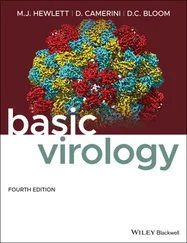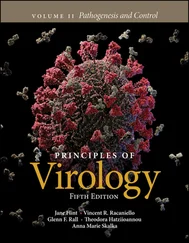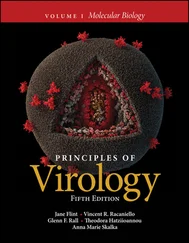Jane Flint - Principles of Virology
Здесь есть возможность читать онлайн «Jane Flint - Principles of Virology» — ознакомительный отрывок электронной книги совершенно бесплатно, а после прочтения отрывка купить полную версию. В некоторых случаях можно слушать аудио, скачать через торрент в формате fb2 и присутствует краткое содержание. Жанр: unrecognised, на английском языке. Описание произведения, (предисловие) а так же отзывы посетителей доступны на портале библиотеки ЛибКат.
- Название:Principles of Virology
- Автор:
- Жанр:
- Год:неизвестен
- ISBN:нет данных
- Рейтинг книги:3 / 5. Голосов: 1
-
Избранное:Добавить в избранное
- Отзывы:
-
Ваша оценка:
- 60
- 1
- 2
- 3
- 4
- 5
Principles of Virology: краткое содержание, описание и аннотация
Предлагаем к чтению аннотацию, описание, краткое содержание или предисловие (зависит от того, что написал сам автор книги «Principles of Virology»). Если вы не нашли необходимую информацию о книге — напишите в комментариях, мы постараемся отыскать её.
Volume I: Molecular Biology
Volume II: Pathogenesis and Control
Principles of Virology, Fifth Edition
Principles of Virology — читать онлайн ознакомительный отрывок
Ниже представлен текст книги, разбитый по страницам. Система сохранения места последней прочитанной страницы, позволяет с удобством читать онлайн бесплатно книгу «Principles of Virology», без необходимости каждый раз заново искать на чём Вы остановились. Поставьте закладку, и сможете в любой момент перейти на страницу, на которой закончили чтение.
Интервал:
Закладка:
From the humble beginnings of the one-step growth curve, many new methods have propelled our understanding of viruses and infected cells to greater depths and at unprecedented speed. An astounding array of technologies, including high-throughput sequencing, proteomics, and single-cell approaches, have been developed. These methods have already led to significant discoveries about viral evolution, reproduction, and pathogenesis. We are truly in a remarkable era, when few experimental questions are beyond the reach of the techniques that are currently available.
REFERENCES
Books
Green MR, Sambrook J.2012. Molecular Cloning: A Laboratory Manual , 4th ed. Cold Spring Harbor Laboratory Press, Cold Spring Harbor, NY.
Maramorosch K, Koprowski H (ed).1968. Methods in Virology . Academic Press, New York, NY.
A series of volumes begun in the 1960s that contain review articles on classic virological methods.
Review Articles
Dulbecco R, Vogt M.1953. Some problems of animal virology as studied by the plaque technique. Cold Spring Harb Symp Quant Biol 18:273–279.
Kuadkitkan A, Wikan N, Smith DR.2016. Induced pluripotent stem cells: a new addition to the virologists armamentarium. J Virol Methods 235:191–195.
Ramani S, Crawford SE, Blutt SE, Estes MK.2018. Human organoid cultures: transformative new tools for human virus studies. Curr Opin Virol 29:79–86.
van Dijk EL, Jaszczyszyn Y, Naquin D, Thermes C.2018. The third revolution in sequencing technology. Trends Genet 34:666–681.
Wang I-H, Burckhardt CJ, Yakimovich A, Greber UF.2018. Imaging, tracking and computational analyses of virus entry and egress with the cytoskeleton. Viruses 10:1–29.
Papers of Special Interest
Ellis EL, Delbrück M.1939. The growth of bacteriophage. J Gen Physiol 22:365–384.
A landmark paper describing the development of the plaque assay to measure infectivity of bacteriophage and its use in studying viral reproduction by one-step analysis.
Reed LJ, Muench H.1938. A simple method for estimating fifty percent endpoints. Am J Hyg 27:493–497.
An important paper that shows how to estimate 50% endpoints in titrations of viruses in animals.
Guo F, Li S, Caglar MU, Mao Z, Liu W, Woodman A, Arnold JJ, Wilke CO, Huang TJ, Cameron CE.2017. Single-cell virology: on-chip investigation of viral infection dynamics. Cell Rep 21:1692–1704.
A seminal paper that presents a pneumatic device for measuring infection of single cells with poliovirus and its use to measure the heterogeneity of infection.
STUDY QUESTIONS
1 Which of the following statements is not correct?The infectious cycle and virus reproduction are synonymousA susceptible cell has a functional receptor for a given virusA cell that is resistant to infection has the viral receptor but the virus cannot be reproduced in itVirus can be reproduced in a permissive cellA susceptible and permissive cell is the only cell in which a virus can enter and be reproduced
2 Which of the following statements about cytopathic effects (CPE) is correct?Some viruses may not produce cytopathic effects in certain cellsSyncytium formation is a type of CPERounding up and detachment of cultured cells is a type of CPEFormation of a viral plaque depends upon CPEAll of the above
3 Which of the following assays determines the number of infectious viral particles?ELISAHemagglutination assayPlaque assayHigh-throughput sequencingPolymerase chain reaction
4 If one million infectious virus particles are added to a culture dish of one million cells, which of the following will happen:Each cell will receive one virus particle because the MOI is 1None of the cells will receive any virus particles37% of the cells are uninfectedOnly one infectious cycle will take placeNone of the above
5 When doing a plaque assay, what is the purpose of adding a semisolid agar overlay on the monolayer of infected cells?To stabilize progeny virionsTo ensure that cells remain susceptible and permissiveTo act as a pH indicatorTo keep cells adherent to the plate during incubationTo restrict viral diffusion after lysis of infected cells
6 In the particle-to-PFU ratio, “particle” can best be described as:One of the proteins which makes up the virionA virus which may or may not be infectiousA virus which is infectiousA virus which is not infectiousElementary or composite
7 The plaque assay plate below was made from a dilution of 10–6 and 0.1 ml of the dilution was plated on the cell monolayer. What is the titer in PFU/ml?
8 Explain why no infectious viruses are observed in the cell culture medium during the latent phase of a onestep growth curve.
9 You infect a plate of one million cells at an MOI of 100. The particle-to-PFU ratio for this virus is 1,000. How many total virus particles did you add to the cells?
3 Genomes and Genetics

Introduction
Genome Principles and the Baltimore System
Structure and Complexity of Viral Genomes DNA Genomes RNA Genomes
What Do Viral Genomes Look Like?
Coding Strategies
What Can Viral Sequences Tell Us?
The “Big and Small” of Viral Genomes: Does Size Matter?
The Origin of Viral Genomes
Genetic Analysis of Viruses Classical Genetic Methods Engineering Mutations into Viral Genomes Engineering Viral Genomes: Viral Vectors
Perspectives
References
Study Questions
LINKS FOR CHAPTER 3
Virocentricity with Eugene Koonin http://bit.ly/Virology_Twiv275
CRISPR-Cas immune systems https://www.microbe.tv/twim/twim-184/
… everywhere an interplay between nucleic acids and proteins; a spinning wheel in which the thread makes the spindle and the spindle the thread.
ERWIN CHARGAFF, 1955
Introduction
Earth abounds with uncountable numbers of viruses of great diversity. However, because taxonomists have devised methods of classifying viruses, the number of identifiable groups is manageable ( Chapter 1). One of the contributions of molecular biology has been a detailed analysis of the genetic material of representatives of major virus families. From these studies emerged the principle that the viral genomeis the nucleic acid-based repository of the information needed to build, reproduce, and transmit a virus ( Box 3.1). These analyses also revealed that the thousands of distinct viruses defined by classical taxonomic methods can be organized into seven groups, based on the structures of their genomes.
Genome Principles and the Baltimore System
A universal function of viral genomes is to specify proteins. However, none of these genomes encode the complete machinery needed to carry out protein synthesis. Consequently, one important principle is that all viral genomes must be copied to produce messenger RNAs (mRNAs) that can be read by host ribosomes. Literally, all viruses are parasites of their host cells’ translation system.
A second principle is that there is unity in diversity: evolution has led to the formation of only seven major types of viral genome. The Baltimore classification system integrates these two principles to construct an elegant molecular algorithm for virologists ( Fig. 3.1). When the bewildering array of viruses is classified by this system, we find seven pathways to mRNA. The value of the Baltimore system is that by knowing only the nature of the viral genome, one can deduce the basic steps that must take place to produce mRNA. Perhaps more pragmatically, the system simplifies comprehension of the extraordinary reproduction cycles of viruses.
Читать дальшеИнтервал:
Закладка:
Похожие книги на «Principles of Virology»
Представляем Вашему вниманию похожие книги на «Principles of Virology» списком для выбора. Мы отобрали схожую по названию и смыслу литературу в надежде предоставить читателям больше вариантов отыскать новые, интересные, ещё непрочитанные произведения.
Обсуждение, отзывы о книге «Principles of Virology» и просто собственные мнения читателей. Оставьте ваши комментарии, напишите, что Вы думаете о произведении, его смысле или главных героях. Укажите что конкретно понравилось, а что нет, и почему Вы так считаете.











